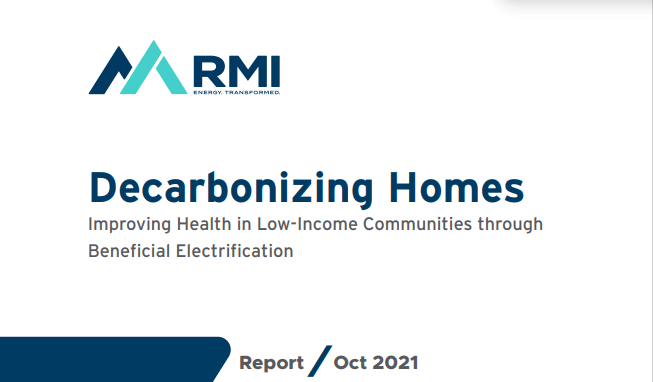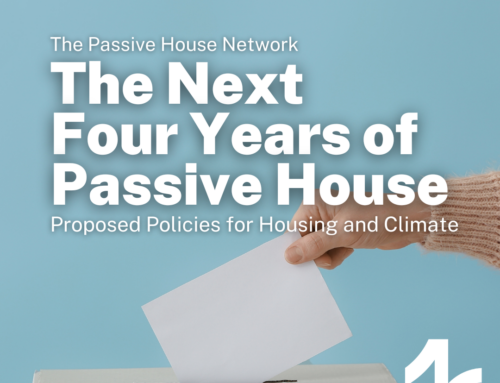
Hello, Beneficial Electrification!
RMI’s report Decarbonizing Homes: Improving Health in Low-Income Communities through Beneficial Electrification by lead authors Yu Ann Tan and Bomee Jung, is an important contribution to our understanding of climate emergency action priorities.
BENEFICIAL ELECTRIFICATION: A NEW PARADIGM
As society rushes to cut greenhouse gas emissions from buildings, too often building performance and net-zero renewable energy approaches remain siloed, and consequently, the resulting buildings are sub-optimal.
This RMI report takes a fresh new approach. It breaks down the silos and makes a recombination, in a new frame, called “Beneficial Electrification”. We love this term and framing. Emerging in 1992 in the utility industry, per the report, it is now crossing over to buildings and specifically housing. The report refines the definition.
“Beneficial electrification of housing should lower housing cost burdens and improve housing quality to create a safe and healthful indoor environment while reducing GHGs and improving how buildings interact with the electric grid.”
In the next breath the report connects the dots and states:
“Effectively and efficiently meeting thermal and indoor air quality needs through all-electric equipment is also inextricably related to the building enclosure and ventilation system. “
And the authors note that beneficial electrification should be understood in the context of equity, and support it, saying in part:
“…but we have expanded upon previous, utility-centric interpretations [of beneficial electrification] to include improving health, safety, and resilience. This expanded view is a step toward equitable electrification. To achieve equitable electrification more fully, additional elements must also be considered, such as protecting against forced displacement, providing additional considerations for renters, and addressing procedural equity, restorative justice, and energy democracy.”
Electrification and renewables no longer should stand alone in our imagination and focus, but be part of a fully integrated whole-system approach that re-invests in our buildings and delivers health, security, and affordability.
THREE BASIC INGREDIENTS
Of course, we recognize the implications of an integrated whole systems approach – it’s called Passive House and the report doesn’t shrink from this implication but instead specifically calls out the Passive House methodology as a core strategy of beneficial electrification.
The formula Passive House + Electrification + Renewables is a simple expression of the integration proposed by beneficial electrification.
The report does a great job of laying out further positive results too: fewer toxins, less pollution, less asthma, allergies, protection from weather extremes, grid resilience, and increased safety for neighborhoods and communities – in particular helping close the gap in health outcomes for low-income communities. (see also Why Passive House?)
TAKING ACTION
Finally, the report lays out recommendations for action:
“State and local governments can take several actions today. The actions below are detailed in the following sections.
1. Adopt enabling policy frameworks for accountability to and agency of low-income communities.
2. Build market capacity and increase funding for existing programs, particularly affordable housing programs, to align with beneficial electrification of housing.
3. Revise codes and standards to expand the reach of health-focused housing initiatives.
4. Advocate for federal initiatives that would make it easier to pursue deep carbon reductions and beneficial electrification in housing.”
And if there was any doubt about the report’s intention of making Passive House the core of beneficial electrification, those doubts melt away in the first call to action, in the subheading of “Use Public and Affordable Housing Programs to Build Market Capacity”, saying:
“To drive beneficial electrification in public and affordable housing, policymakers can:
-
-
- Require all new affordable housing to be all-electric passive house [our emphasis] construction by 2025. Setting a 2025 deadline for the beneficial electrification of new affordable housing sends a clear market signal while allowing the construction market several affordable housing construction cycles to prepare.”
-
Up to now, as the mantra of net-zero and its focus on electrification and renewables has gained momentum, it threatens to further entrenched disparities, and deepen them.
CONCLUSION
In the conclusion, the authors point to the unique synergies beneficial electrification can unlock.
“The synthesis here, which links health harms to housing quality deficiencies and fossil fuel combustion, shows that beneficial electrification is a necessary step to improve health in low-income communities.”
The formulation of Passive House + Electrification + Renewables is not new – but people have struggled to find the right vocabulary, terminology and framing. Beneficial electrification just might do the job.
Let’s deliver the climate, health and social solutions we so desperately need. Let’s extend the benefits of beneficial electrification to everyone.
READ THE REPORT
Get Trained:
Introductory Training Options
Core Certification Training Options
Specialized Training Options




